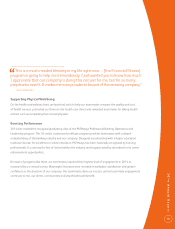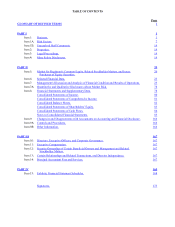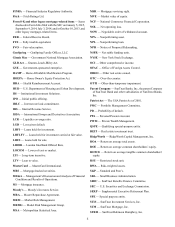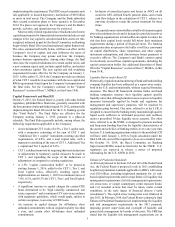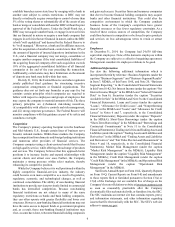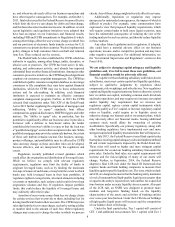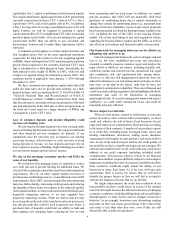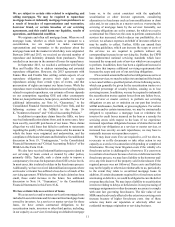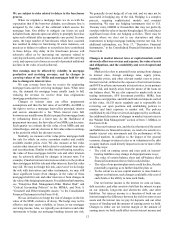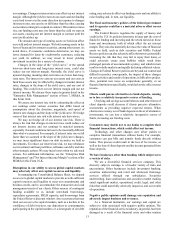SunTrust 2014 Annual Report Download - page 26
Download and view the complete annual report
Please find page 26 of the 2014 SunTrust annual report below. You can navigate through the pages in the report by either clicking on the pages listed below, or by using the keyword search tool below to find specific information within the annual report.3
implementing this requirement. The FDIC issued a separate such
rule applicable to insured depository institutions of $50 billion
or more in total assets. The Company and the Bank submitted
their second resolution plans to these agencies in December
2014. If a plan is not approved, the Company’s and the Bank’s
growth, activities, and operations may be restricted.
Most recently, federal regulators have finalized rules for new
capital requirements for financial institutions that include several
changes to the way capital is calculated and how assets are risk-
weighted, informed in part by the Basel Committee on Banking
Supervision's Basel III revised international capital framework.
The rules, summarized briefly below, will have an effect on the
Company's level of capital, and may influence the types of
business the Company may pursue and how the Company
pursues business opportunities. Among other things, the final
rules raise the required minimums for certain capital ratios, add
a new common equity ratio, include capital buffers, and restrict
what constitutes capital. The new capital and risk weighting
requirements became effective for the Company on January 1,
2015. At December 31, 2014, the Company provides an estimate
of what CET 1 would be in accordance with the new capital and
RWA requirements based upon the Company's interpretation of
the final rules. See the Company's estimate in the "Capital
Resources" section of Item 7, MD&A, in this Form 10-K.
Capital Framework and Basel III
On July 9, 2013, the Federal Reserve, jointly with other federal
regulators, published three final rules, generally consistent with
the three proposed rules published August 30, 2012, substantially
implementing the Basel III accord for the U.S. banking system
(the “Final Rules”). The Final Rules are effective for the
Company starting January 1, 2015, pursuant to a phase-in
schedule. The Final Rules generally include, among others, the
following requirements applicable to the Company:
• A new minimum CET 1 ratio of 4.5%; a Tier 1 capital ratio,
with a numerator consisting of the sum of CET 1 and
“Additional Tier 1 capital” instruments meeting specified
requirements, of 6.0%; and a total capital ratio, with a
numerator consisting of the sum of CET 1, Additional Tier
1 capital and Tier 2 capital, of 8.0%.
• CET 1 is defined narrowly by requiring that most deductions
or adjustments to regulatory capital measures be made to
CET 1, and expanding the scope of the deductions or
adjustments as compared to existing regulations.
• A 2.5% “capital conservation buffer” to be phased-in
starting January 1, 2016, added to the CET 1, Tier 1, and
Total Capital ratios, effectively resulting (upon full
implementation on January 1, 2019) in minimum ratios of
7.0%, 8.5%, and 10.5% for CET 1, Tier 1, and Total Capital,
respectively.
• A significant increase to capital charges for certain CRE
loans determined to be “high volatility commercial real
estate exposures” and a minimum LTV ratio in accordance
with regulatory guidelines, which would apply, subject to
certain exceptions, to an array of CRE loans.
• An increase in capital charges for off-balance sheet
unfunded commitments with an original maturity less than
a year, and certain other off-balance sheet unfunded
commitments.
• Inclusion of unrealized gains and losses in AOCI on all
securities AFS, defined benefit pension plans, and certain
cash flow hedges in the calculation of CET 1, subject to a
one-time election to retain the current treatment for these
items.
The capital conservation buffer is a buffer of common equity
above the minimum levels and is designed to provide incentives
for banking organizations to hold sufficient capital to reduce the
risk that their capital levels would fall below their minimum
requirements during a period of financial stress. If a banking
organization does not preserve the buffer it will face constraints
on capital distributions, share repurchases and other capital
instrument redemptions, and discretionary bonus payments to
executive officers. The Company's and Bank's current capital
levels already exceed these capital requirements, including the
capital conservation buffer. See additional discussion of Basel
III in the "Capital Resources" section of Item 7, MD&A, in this
Form 10-K.
Liquidity Ratios under Basel III
Historically, regulation and monitoring of bank and bank holding
company liquidity has been addressed as a supervisory matter,
both in the U.S. and internationally, without required formulaic
measures. The Basel III framework dictates banks and bank
holding companies measure their liquidity against specific
liquidity ratios that, although similar in some respects to liquidity
measures historically applied by banks and regulators for
management and supervisory purposes, will be required by
regulation going forward. One ratio, referred to as the LCR, is
designed to ensure that the banking entity maintains high quality
liquid assets sufficient to withstand projected cash outflows
under a prescribed 30-day liquidity stress scenario. The other
ratio, referred to as the NSFR, is designed to promote medium
and long-term funding based on the liquidity characteristics of
the assets and activities of banking entities over a one-year time
horizon. U.S. banking organizations subject to the modified LCR
will have until January 1, 2016 to begin calculation under the
final LCR rule and will be required to do so on a monthly basis.
On October 31, 2014, the Basel Committee on Banking
Supervision (BCBS) issued its final rules for the NSFR. U.S.
regulators are expected to release a notice of proposed
rulemaking for the U.S. NSFR in 2015.
Enhanced Prudential Standards
As directed pursuant to Sections 165 and 166 of the Dodd-Frank
Act, the Federal Reserve proposed a rule in 2011 establishing
heightened prudential standards applicable to BHCs with assets
over $50 billion, including heightened standards for: (i) risk-
based capital requirements and leverage limits; (ii) liquidity risk
management requirements; (iii) risk management requirements;
(iv) stress tests; (v) single counterparty credit exposure limits;
and (vi) remedial actions that must be taken, under certain
conditions, in the early stages of financial distress (“early
remediation”). The capital stress testing rules were finalized in
late 2013. In February 2014, the Federal Reserve adopted a final
Enhanced Prudential Standards rule implementing the liquidity
and risk management requirements in the 2011 proposal,
imposing greater supervision and oversight of liquidity and
general risk management by boards of directors. The FRB has
stated that the liquidity risk management requirements are in



